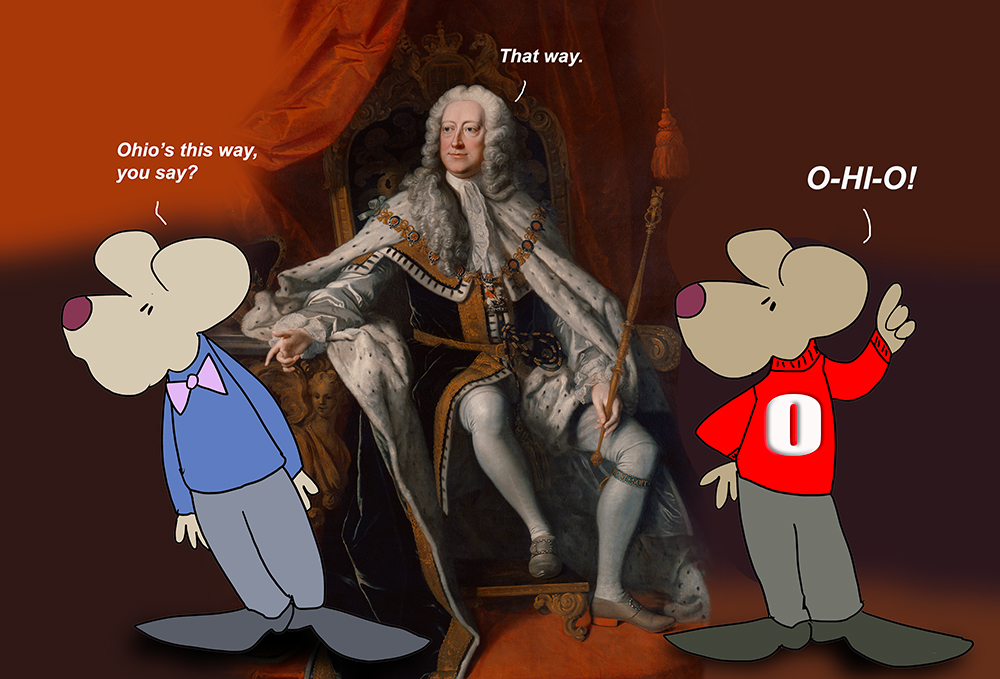It was a warm morning, on May 15, 1749, when England’s King George II rolled over in his royal bed and plopped on his curled-up wig before placing his feet on the floor. He hadn’t even had his tea yet. But something inexplicable weighed heavy on his mind. It was a chant. Over and over again, he’d heard it in his dreams. And there it was again. O-HI-O! O-HI-O! He spelled the letters in the air, flinging his arms overhead.
Later that day, he swirled his signature on an official deed, granting the Ohio Company of Virginia a charter of 200,000 acres that stretched out from the forks of the Ohio River on the present site of Pittsburgh. A land called O-HI-O. Where chocolate candies, stuffed with creamy peanut butter goo, would rule the day.
That’s sort of how it happened, maybe. But George II really granted such a thing, and that is how this State got its early beginnings.
The royal charter stipulated that the company build a fort to protect the settlers because they were English, and they’d be taking land that wasn’t theirs. It was stipulated that the company had to move at least 100 families into the area as well. So it would go, that wealthy Virginia planters challenged century-old French claims to the entire Ohio River Valley.
On the French side of things, the explorer René-Robert Cavelier had laid claim to a vast land area called New France. “His” claim stretched from the Appalachian Mountains in the east to the Rocky Mountains in the west and from the Great Lakes in the north to the Gulf of Mexico in the south. Now that’s a pretty big chunk of land. It included O-HI-O. But the thing was, only a few French farmers lived in New France. Like, next to none. Most of the French in the area were fur traders.
But the British had a plan. When their fur traders began to move into the Ohio Valley, they coaxed business away from the French. The British offered the Indians more goods for fewer furs. So, it wasn’t long before the Indians made all their trades with the British, and the French were out.
But the British had to push things further with the settlement of American colonists in this new region. By doing so, the Ohio Company helped provoke the seven-year French and Indian War.
Of course, the Native Americans were somewhat torn. They fought on both sides of the conflict but were mostly allied with the French. The Iroquois, however, sided with the American colonists and Britain.
The war began in 1754. Our good George Washington was still wet behind the ears. He was just a 21-year-old major at the time. Washington tried to confront the French at Fort Duquesne (now Pittsburgh). He fought against a French faction before reaching the fort. Some big-wig French officer was killed, and that elicited a strong French response. So young George had to retreat, tail tucked between his legs.
Anyway, the French were defeated in 1763. And the Ohio River Valley and the Great Lakes became part of British Canada. The Ohio Company was ready to exploit the region further.
After a short time, the settlers resented these arrangements made by the British. So, in time, they joined the ranks of the Patriots in their struggle against the British. We know it as the American Revolution — with Washington serving as the Patriots’ commander in chief. George, all grown up. In 1783, Britain ceded Ohio to the United States under the Treaty of Paris.
The first “permanent” settlement in Ohio was Marietta, founded in 1788. During the coming decade, Indians and British traders were pushed out. Ohio became the 17th State in 1803, just 54 years after King George II had his dream.
And this is where I live.
===========
Ohio has the largest Amish population of any state in the nation.
============
Ohio didn’t officially become a state until 1953. It was declared a state in 1803, but didn’t get the presidential stamp of approval until President Dwight Eisenhower signed off. He back-dated the declaration to the original date.
===========
Before going into television, Jerry Springer was the 56th mayor of Cincinnati. He considered running for Senate, but was concerned that his show’s negative reputation would affect his chances.
===========
What is round on the ends, and high in the middle?
